An iceberg threatens a village in Greenland, July 2018, Magnus Kristensen
For a week in July 2018, a giant 100m-tall iceberg loomed over a tiny village on the west coast of Greenland. Villagers were evacuated, and the world watched in suspense: if a chunk of the 10m-tonne iceberg had broken apart or “calved”, it would have caused a tsunami and obliterated the settlement of Innaarsuit. Eventually, it drifted away from the shore – but as glaciers melt, we can expect to see more masses of ice breaking off and floating dangerously close to land.
Dust storms hit New South Wales, Australia, January 2020, Jason Davies
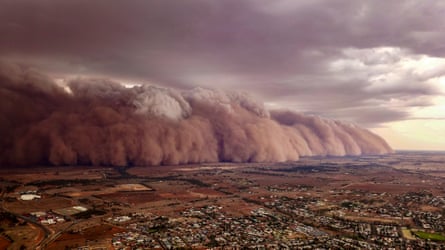
This drone-captured image shows a monster dust storm that engulfed central New South Wales in Australia in January 2020. One local resident described the scene as “like an apocalyptic movie”. Drier conditions caused by climate change have been linked to an increase in the frequency and severity of sand and dust storms across the globe. As well as affecting agriculture, industry and the climate itself, airborne dust can cause serious health problems.
A family clings to life in a wildfire, Tasmania, January 2013, Tim Holmes

Seen as the defining image of the fires that ravaged Australia in 2013, this photo shows a woman and her five grandchildren taking refuge in the water under a jetty. A bushfire had engulfed their home in a small fishing town in Tasmania. The image was shot by the children’s grandfather, Tim Holmes, before he managed to retrieve a dinghy in which the family could evacuate. “The atmosphere was so incredibly toxic,” Holmes told an interviewer soon after. “We were all just heads, water up to our chins, just trying to breathe.”
China’s record-breaking heatwave, August 2022, Thomas Peter
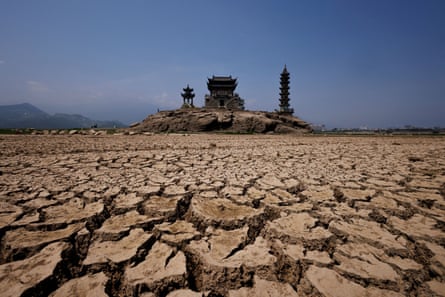
The worst heatwave ever recorded took place in China this summer. Soaring temperatures, drought and wildfires led to crop failures, power shortages and factory shutdowns. In this dramatic image, the pagodas of Luoxingdun Island can be seen towering over the dried-out bed of the country’s largest freshwater lake in the south-east Jiangxi province.
A man pushes children on a satellite dish through flooding in the Jaffarabad district of Pakistan, August 2022, Fida Hussain
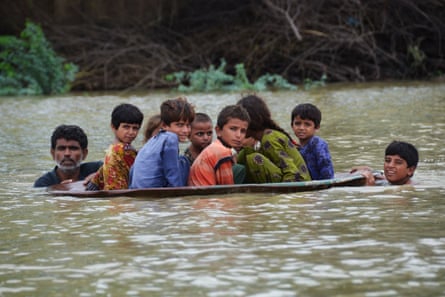
Catastrophic flooding in Pakistan this summer submerged a third of the country, destroying homes, communities and livestock. An estimated 33 million people – that’s one in seven of the population – have been affected. At least 1,700 have died. Waterborne diseases and malnutrition are among the main continuing health threats. The long-term economic impact will be vast.
Scientists believe climate change is likely to have supercharged the intense rainfall that led to the flooding. UN secretary general António Guterres called it a “monsoon on steroids”. And worryingly, such extreme flooding events are likely to become more frequent around the world.
Pakistan’s climate minister, Sherry Rehman, has issued a call for “reparations” from richer countries with higher emissions. As she said in September, “Global warming is the existential crisis facing the world, and Pakistan is ground zero – yet we have contributed less than 1% to emissions.”
The British-Pakistani novelist Kamila Shamsie agrees. “The world’s richest countries are the ones most responsible for the climate catastrophe, and it’s the poorer nations who are paying the heaviest price. We need urgent and binding commitments from the G20 nations towards net zero,” she says. “As for the poorer nations, such as Pakistan, where the calamity has already occurred, ‘financial aid’ isn’t what is needed – we need to stop using that phrase and replace it with words such as: ‘climate justice’, ‘reparation’, ‘obligation’.”
Giraffes die of thirst in Kenya, December 2021, Ed Ram

Over the past two years, the Horn of Africa has experienced the worst drought in more than four decades, leading to millions of deaths of humans and animals. The devastation is encapsulated in this aerial shot by photojournalist Ed Ram, showing the carcasses of six giraffes strewn across the arid ground on the outskirts of a village in Kenya’s Wajir county. The animals died after getting stuck in mud when trying to drink from a reservoir that had almost dried up.
SOS sign in Puerto Rico during Hurricane Maria, September 2017, Angelina Ruiz-Lambides
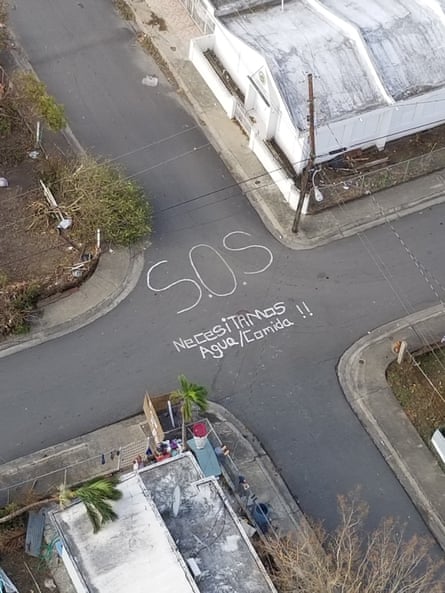
This photograph of an SOS sign scrawled on the pavement in the coastal town of Punta Santiago in Puerto Rico became the defining image of Hurricane Maria, the lethal storm that swept through the northern Caribbean in September 2017. Around 3,000 people died and the disaster caused $90bn (£80bn) in damage. Across Puerto Rico, power was cut off; an aid official spotted this distress signal during an aerial assessment of the aftermath. The snap was circulated on social media and brought help to Punta Santiago soon after.
The image left no doubt that we are already in a climate emergency. Huge storms routinely devastate coastal and island populations, with marginalised communities – which usually have weaker infrastructure, fewer resources for evacuation and insufficient insurance cover – disproportionately affected.
And so-called “natural disasters” are being turbocharged by the warming planet. Kerry Emanuel, a meteorologist who has spent more than 40 years studying the links between hurricanes and climate change, explains: “Hurricanes are powered by the flux of heat from the ocean to the atmosphere when sea water evaporates. Theory, models and observations all point to increasing wind speeds and rainfall in hurricanes as a consequence of global warming.”
How does it feel to be on the frontline of a hurricane disaster? “Being on the island and completely disconnected, we didn’t realise how far our picture travelled,” said resident Janet Gonzalez a year after Maria hit Puerto Rico. “We’re thankful that it did. But now, we’re ready to turn the page.”
A minister addresses Cop26 while standing in seawater, Tuvalu, 2021, Tuvalu Ministry of Justice, Communication and Foreign Affairs
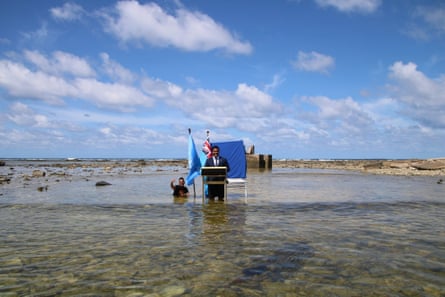
In one of the most memorable moments of last November’s Cop26, the foreign minister of Tuvalu, an island nation in the south Pacific, addressed a speech to the summit while knee-deep in the Pacific. “Climate change and sea level rise are deadly and existential threats to Tuvalu and low-lying atoll countries,” Simon Kofe said. “We are sinking.”
“We have to bring these images to people who don’t understand the context of low-lying island states,” the politician says now of his video, “so they can appreciate our reality when we say we may lose everything.”
In countries such as Tuvalu, where “you live on thin strips of island and can see the lagoon on one side and the ocean on the other”, the effects of the rising temperatures and ocean are already many and varied, explains Kofe. They include droughts, coastal erosion, increased salinity (which affects crops), and “much stronger tropical cyclones, which have wiped out parts of islands”.
Many Pacific island nations may become uninhabitable within decades. You could argue that this is particularly unjust given that they jointly contribute less than 0.03% of the world’s carbon emissions. But Kofe says recent extreme weather events show that “every single person is now affected” by climate change. “This is why we have to come together to combat this threat, no matter where we live.”
On the response to the speech he gave at Cop26, Kofe says: “I was very hopeful when seeing the massive popularity of the footage and the interest in the climate‑change impacts we face from around the world. However, interest and action are different things. We must continue bringing our message to major emitters.”
Earthrise, December 1968, William Anders
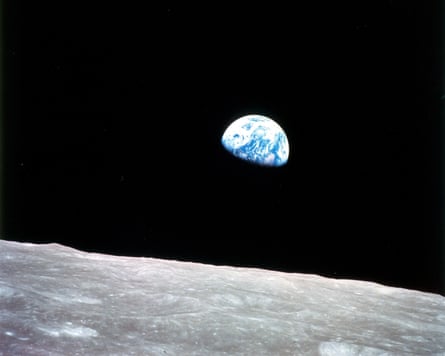
This celebrated image of the Earth emerging beyond the lunar horizon has been credited with kickstarting the modern environmental movement. The landscape photographer Galen Rowell called it “the most influential environmental photograph ever taken”. Earthrise was captured by astronaut William Anders on 24 December 1968 during the Apollo 8 voyage – the first crewed mission to orbit the moon. “People realised that we lived on this fragile planet and we needed to take care of it,” Anders later observed of the photograph’s impact. “This is the only home we have.”
Wildfires in Greece, August 2021, Konstantinos Tsakalidis
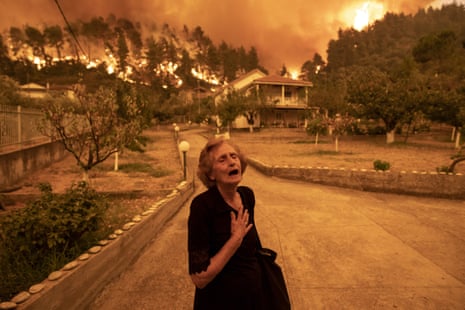
In the summer of 2021, wildfires raged across the Mediterranean. This image of an elderly woman bathed in the orange light of flames has become an unforgettable symbol of the destruction. Captured on 8 August 2021, it depicts 81-year-old Panayiota Kritsiopi fleeing from her home on the Greek island of Evia. “At that moment I was shouting, not only for myself, but for the whole village,” Kritsiopi said later.
Amazon deforestation in Brazil, August 2019, Mayke Toscano
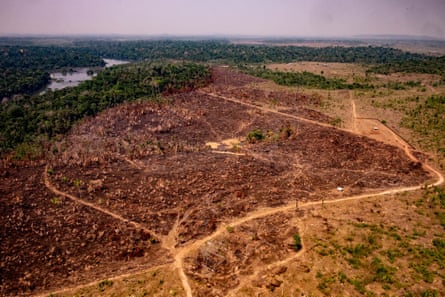
The deforestation of the Amazon rainforest has become an emblem for the human-driven destruction of our planet. This aerial view of razed forest in the Brazilian Amazon was taken in 2019, in the first year of the presidency of Jair Bolsonaro, who in nearly four years has overseen a staggering rise in deforestation rates, which are around 75% higher than in the previous decade. Fires are often used to clear the land, mostly for beef and soy farming, which results in drier conditions and further uncontrolled blazes – a vicious cycle that means the former carbon sink now produces more emissions than it is capable of absorbing.
Flooding in Venice, Italy, November 2019, Filippo Monteforte
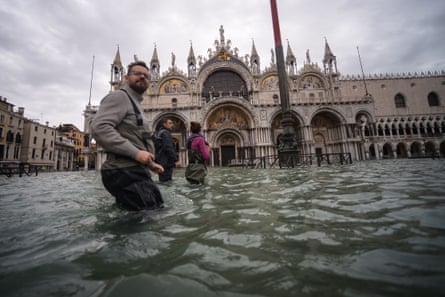
“Venice is eternity itself,” said the poet Joseph Brodsky. But can the famously precarious “floating city” survive that long? Three years ago, Venice was hit by its worst floods in more than half a century. This shot of people standing thigh-deep in water in front of St Mark’s Basilica captures the scale of the flooding. More than 80% of the city was submerged, causing damage estimated at €1bn (£867m). Two people died.
In addition to the sinking or subsidence of the land, rising sea levels around Venice increase the likelihood and severity of extreme flooding. As journalist and campaigner for Venetian heritage Anna Somers Cocks explains, “The mean water level in the Venetian lagoon is already 50cm higher than in 1897, when scientific measurements were first made.” The threat of floods has already driven many locals away from the historic city centre, which currently has only around 52,000 permanent inhabitants (down from 175,000 in 1951). “It has become too difficult to stay,” said Patricia Blaci, one former resident whose home was damaged in 2019. “It’s like living on a boat.”
Since 2020, a system of retractable barriers has been used to hold back the worst tides, but there is still cause for concern. If the sea level rise continues on its current track, then “the barriers would have to be closed around 260 times a year”, says Somers Cocks. This would jeopardise the delicate ecosystem of the lagoon. Besides, the Venice port authority won’t allow the barriers to be used that frequently because they prevent ships from entering and leaving the port.
Even if floods can be prevented, the rising sea means that, throughout Venice, buildings are being corroded by salty water and growing increasingly unstable. It’s no surprise that many residents are giving up and leaving their homes. “The chronically raised water levels are still eating away at the fabric of the city,” says Somers Cocks.
A ghost village emerges in Galicia, Spain, February 2022, Brais Lorenzo
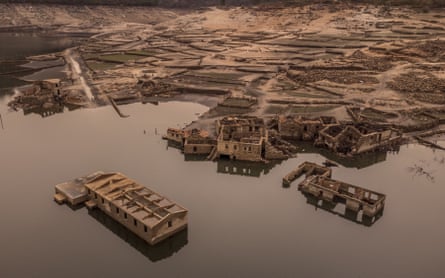
Record-breaking droughts this year have unearthed a series of long-buried objects across the world, including a circle of megalithic stones dubbed “the Spanish Stonehenge”, second world war battleships, and 19th‑century shipwrecks. This photograph shows the eerie scene of a ghost village that surfaced during a drought in the Galicia region of Spain. The small settlement of Aceredo, previously home to around 120 people, had been flooded in 1992 to create a reservoir. Three decades later, the nearly empty reservoir revealed a remarkably intact site. Amid the houses and streets, visitors spotted astonishing details, such as a drinking fountain still spurting water, stacked crates of empty beer bottles, and a rusted car.
Coral bleaching at the Great Barrier Reef, Australia, March 2017 Brett Monroe Garner
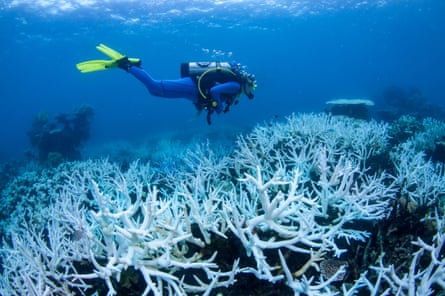
Marine scientist Charlie Veron, dubbed the “godfather of coral” for his pioneering work in the field, took the first published photo of bleached coral in the early 1980s. At the time, he thought it was a new species of the usually colourful organism. Now we know that ghostly white corals – as seen in this photograph taken at the Great Barrier Reef in 2017 – are a clear warning sign of an ecosystem in distress.
As Veron explains, healthy coral reefs get their vibrant colours from microscopic algae called zooxanthellae. They and the coral have a symbiotic relationship, providing each other with the nutrients needed to survive. But “at peak temperatures, the algae overproduce oxygen and thus become pathogens. The corals expel the algae and can starve to death.” With warming ocean temperatures, mass bleaching events – followed by coral decay and reef collapse – are triggered more frequently. “Reef corals have been in serious decline for more than two decades. The Great Barrier Reef has lost about half its corals, a process that is accelerating,” Veron says.
The consequences of this damage are far-reaching. As Veron puts it: “The Great Barrier Reef is the world’s greatest marine natural icon, yet its loss is not the worst of it. About half of all marine species spend some part of their lifecycle in coral reefs. Loss of coral reefs will precipitate a worldwide ecological collapse of our oceans and that means the start of global mass extinction.”
A company spray-paints grass green, California, US, May 2015, Justin Sullivan

For the past two decades, California has had its worst drought in more than a millennium. This image of a man spraying a dried-up lawn with green paint was taken in spring 2015, an especially dry period. Around the world, people were stunned by reports of businesses offering this strange service – applying such a superficial fix to the effects of a severe crisis seemed absurd. Jim Power, founder of grass-paint manufacturer LawnLift, was defiant: “People think it sounds ridiculous when they first hear about it, but they try it, and instantly they’re hooked.”
Huskies pull a sledge through water, Greenland, June 2019, Steffen M Olsen
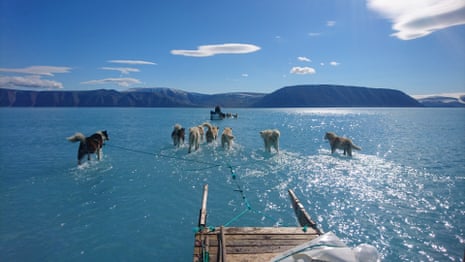
This startling image of husky dogs pulling a sledge through melted ice in north-west Greenland was captured by Steffen Olsen, a scientist with the Danish Meteorological Institute. Olsen and a team of local hunters were collaborating on a project to monitor climate change, ocean conditions and the sea ice in the Inglefield fjord. He snapped the photo on his phone during an unsuccessful attempt to retrieve the team’s scientific instruments before the ice melted. “We had not previously experienced water on the ice this early in the summer,” he recalls. “The local team working with me said this was beyond anything they had experienced before.”
Olsen’s image, shared by a colleague on Twitter, went viral: an illustration of the alarming pace at which the sea ice in Greenland and the Arctic is disappearing. As Olsen explains: “This is a response to warming atmospheric temperatures. When ice retreats earlier in spring and forms later in the autumn, more solar radiation can heat the ocean, and sea ice forms even later.”
In 2019, the Greenland ice sheet lost 532bn tonnes of ice – double the annual average since 2003. This accelerated melting contributes directly to a global rise in sea levels, with what Olsen describes as “vast environmental impacts”, including increased coastal erosion and loss of marine habitats.
Reflecting on the unexpected impact of his snap, Olsen says: “I know of people who have engaged in climate and sustainability initiatives due to this photo. I am grateful that it has helped to alert people to the extreme events in the Arctic system and the wider climate crisis.”
A Queen’s Guard is given a sip of water during the record-breaking heatwave, London, July 2022, John Sibley
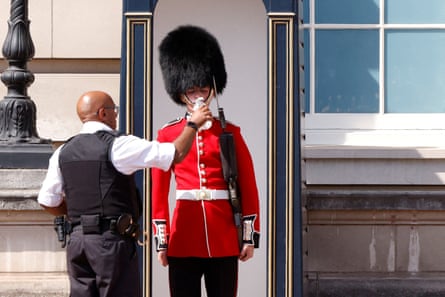
Might the record temperatures in the UK this summer be the wake-up call we need? A reading of 40.3C was recorded in the Lincolnshire village of Coningsby on 19 July. This is startling for a country renowned for its temperate maritime (read: soggy) climate. And in fact, high humidity in the UK – which makes it harder for sweat to evaporate and cool our bodies – can exacerbate the effects of the heat.
It is increasingly clear that the UK is not built for or adequately adjusting to the heat – a situation perfectly encapsulated in this image of a Buckingham Palace guard, uniformed in the traditional red tunic and bearskin hat, having to be given a sip of water. Several newspapers used it on their front pages. “This is stupid and irresponsible,” one Twitter user responded, suggesting a switch to a more heat appropriate uniform.
The Met Office says that in a high-emissions scenario the UK “could see temperatures exceeding 40C as frequently as every three years by the end of the century”. Goodbye, bearskin hats.
Golfers in Washington state during a wildfire, September 2017, Kristi McCluer
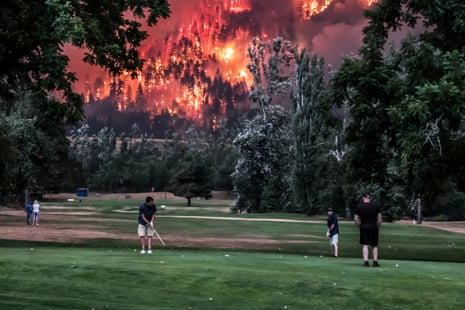
“In the pantheon of visual metaphors for America today, this is the money shot,” tweeted the TV writer (and creator of The Wire) David Simon in response to this image of golfers calmly putting against the backdrop of a wildfire. It was snapped by local amateur photographer Kristi McCluer, in 2017, on the third day of a fire that swept the Columbia River Gorge in Oregon and Washington for three months, burning 50,000 acres.
Polluted New Year in Mexicali, Mexico, January 2018, Eliud Gil Samaniego
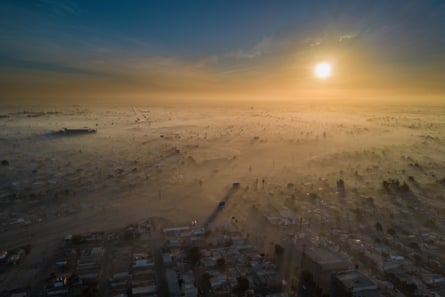
The sun burns fiercely above an urban landscape shrouded in smog. This is Mexicali, a city just south of the US-Mexico border – one of the most polluted cities in North America – photographed on New Year’s Day in 2018. Air pollution and climate change are closely linked: both are driven largely by burning fossil fuels, while hot weather makes smog more likely to form. The World Health Organization estimates that pollutants in the air we breathe contribute to 7m premature deaths a year from all sources, indoor and outdoor. Of these, 3.6m are estimated to come from burning fossil fuels.
A starving polar bear, Canada, July 2017, Cristina Mittermeier

“We wanted people to realise that when scientists say polar bears might become extinct, the way they will die is through slow, painful starvation,” says conservation photographer Cristina Mittermeier. In December 2017, Mittermeier and her husband, fellow photographer Paul Nicklen, made worldwide headlines after publishing footage of an emaciated polar bear struggling across iceless terrain in the Canadian Arctic.
There was some controversy, with critics (including some climate crisis deniers) arguing that it’s impossible to prove exactly why this particular creature was so ill. But experts agree that polar bears in general are at serious risk. “The Arctic is warming four times faster than the rest of the planet, melting the sea ice that polar bears require,” says Krista Wright, executive director of Polar Bears International. “Research shows that if business-as-usual greenhouse gas emissions continue, it’s likely that all but a few polar bear populations will collapse by 2100.”
Mittermeier stands by the photograph and video because they prompted a bigger conversation about the climate crisis. “Photography is one of the most effective and powerful tools we have to tell complex stories, like the story of climate change,” she says. Polar bears are a “canary in the coalmine”, as Mittermeier puts it, for an entire planet in distress.